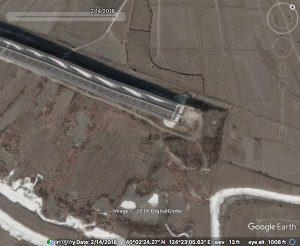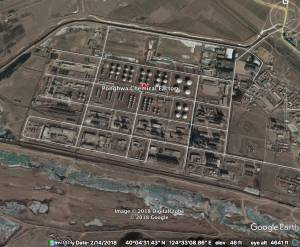By Benjamin Katzeff Silberstein
North Korea imported luxury goods from China for at least $640 million, says one South Korean lawmaker. Reuters:
“Kim has bought lavish items from China and other places like a seaplane for not only his own family, and also expensive musical instruments, high-quality TVs, sedans, liquor, watches and fur as gifts for the elites who prop up his regime,” opposition lawmaker Yoon Sang-hyun said in a statement.
“With the growing loophole, Kim would be able to near his goal of neutralizing sanctions soon without giving up the nuclear weapons.”
Last year, North Korea spent at least $640 million on luxury goods from China, according to Yoon.
China does not provide breakdowns of its customs figures. Yoon compiled data based on a list of banned items crafted by Seoul in line with a 2009 U.N. resolution.
Beijing’s customs agency did not immediately respond to a request for comment. Beijing has said it strictly abides by international sanctions against North Korea.
The 2017 luxury trade volume was down from the 2014 peak of $800 million, but was only a 3.8 percent drop from $666.4 million in 2016, according to Yoon.
The luxury items accounted for 17.8 percent of North Korea’s entire imports from China last year which totaled $3.7 billion, Yoon said.
Purchases of electronic products such as high-end TVs made up for more than half of the total transactions, worth $340 million, followed by cars with $204 million and liquors with $35 million.
China’s trade with North Korea from January to August this year tumbled 57.8 percent from the year-earlier figure to $1.51 billion, China’s customs agency said last month.
But Yoon’s analysis also shows North Korea funneled more than $4 billion into luxury shopping in China since Kim took power at the end of 2011.
Yoon accused China of loosening enforcement of sanctions, and criticized South Korea’s recent request for U.N. and U.S. exemptions to restart inter-Korean economic cooperation.
Full article:
North Korea bought at least $640 million in luxury goods from China in 2017, South Korea lawmaker says
Hyonhee Shin
Reuters
2018-10-22
Now, none of this means that Kim Jong-un is personally swimming in a sea of handbags and TV-sets in Pyongyang. Rather, it means that North Korea – whether semi-private companies or state entities – has imported a fair amount of so-called luxury goods, despite sanctions that should prevent such imports. The term “luxury goods”, moreover, is too broad in this case and encompasses several items that wouldn’t necessarily be classified as “luxurious” by most.
At the same time, UN institutions estimate that 1/4 of children in rural North Korea are underweight. As Chosun Ilbo reports:
The wealth gap between country and city is widening. One in every four rural children is undernourished and underweight and the North has the most serious poverty issue in East Asia, the FAO said.
The wealth gap between country and city is widening. One in every four rural children is undernourished and underweight and the North has the most serious poverty issue in East Asia, the FAO said.
The proportion of underweight children in rural areas is 27 percent but only 13 percent in the cities.
Full article:
1/4 of Rural Kids in N.Korea Underweight
Kim Myong-song
Chosun Ilbo
2018-10-18
The World Food Program (WFP), meanwhile, has only received 27 percent of their funding appeal for 2018:
According to Herve Verhoosel, a spokesperson for the World Food Programme (WFP), the UN agency is staring at a massive 73 per cent shortfall in funding for 2018, hurting critical programmes such as nutritional support for children.
“We must not wait for diplomatic progress to alleviate the suffering of millions of people – funds are urgently needed now,” said Mr. Verhoosel.
“Any donation we receive today will take at least six months to reach the people who need it, due to the time it takes to purchase and transport food.”
A lack of funding risks reversing small gains in nutrition for mothers and children, made over the past four years, on the back of concerted efforts by humanitarians. Limited funding has also resulted in the suspension of operations to build resilience among disaster-hit and vulnerable communities.
WFP needs $15.2 million over the next five months to avoid further cuts to programmes which help feed around 650,000 women and children each month.
Across the country, which is officially known as the Democratic People’s Republic of Korea (DPRK), more than 10 million people – almost 40 per cent of the population – are undernourished and in need of support, with one in five children stunted due to chronic malnutrition.
The country is also vulnerable to natural disasters, such as drought and flooding, which affect agricultural production and livelihoods.
Article source:
Critical food programmes in North Korea can’t wait for ‘diplomatic progress’, UN food agency warns
UN News
2018-10-09
So, what is really going on here? Is it accurate to say, like the headlines imply, that North Korea’s leadership is simply buying a bunch of luxury items for millions of dollars and letting children starve in the countryside? Is there a real risk that humanitarian aid can be diverted to the army, and what does this really mean? These are separate questions, but they are interrelated in the sense that they all touch upon Pyongyang’s incentives and policy choices when it comes to its humanitarian situation.
On 38 North, the host website of this blog, Kee Park and Eliana Kim show convincingly that the fear of diversion of aid to the military is exaggerated and unfounded:
International donors and organizations have become increasingly reluctant to provide funds to North Korea. Although five countries—Switzerland, Sweden, Canada, France and Russia—have responded to the UN’s request this year, there is still a funding gap of $88.1 million. Previous donors such as United Kingdom, Australia, Japan, Ireland, South Korea and others remain uncommitted. One concern frequently cited for this reluctance is that foreign aid, including critical humanitarian aid, will either be diverted to the military or fund the nuclear weapons and missile programs or take pressure off of the regime to provide for its people.
However, these concerns are based on basic misunderstandings of how and why humanitarian assistance is provided to North Korea. Facts on the ground show that the potential for diversion is minimal and the main benefactors are generally not government or military institutions. Given the mission of UN humanitarian assistance, denying the DPRK this assistance for political purposes is both unethical and inhumane.
Full article:
The Case for Funding the UN’s Request for Humanitarian Assistance to the DPRK
Kee B. Park and Eliana E. Kim
38 North
2018-10-23
One of their most central arguments is that opportunities for diversion are too small to be meaningful. Overhead costs only make up a small percentage of total costs, and little of it could even hypothetically be diverted given that it’s all needed to run UN operations in the country. When it comes to diversion of actual food aid, the authors argue that most diversion that may occur is done towards the markets – that is, the state doesn’t actually take foodstuffs for its own use, and resources that are used elsewhere do not necessarily benefit the North Korean government.
It also seems like diversion was much more of a real concern in the 1990s and early 2000s. The worry was primarily about diversion of food aid to the military and away from society’s most needy, and it wasn’t unfounded at all. But we have to assume that there’s been a great deal of learning done by NGOs and international institutions present on the ground. They know what they’re doing.
Today, food aid volumes aren’t large enough to be meaningful for the army to try to divert, it seems, even if they would want to. Much of the aid, moreover, consists not of rice and other goods consumed by the general public, but likely of nutritional assistance designed to maximize the caloric intake of vulnerable groups such as children and breastfeeding mothers. We also have to remember that the chain of aid distribution and reception is long and diverse. Park and Kim argue that Pyongyang has invested much more in recent years to meet humanitarian needs. I would add that people who have worked with humanitarian aid delivery on the ground have often commented on how local officials and staff members, regardless of what one might think of Pyongyang’s intentions, are often passionate and genuine in their will and hard work to ensure that food aid reaches their local constituents and intended recipients.
However, this angle misses an important point. Diversion isn’t just about the army grabbing bags of rice intended for malnourished children, it’s also, arguably, about resources in the bigger picture. At the end of the day, for the North Korean regime, feeding the most vulnerable is a matter of priority. We know it could, should it choose to do so. Even in years when North Korean harvests have likely been lower than this year (which we don’t yet have figures for) given the upward trend in harvests over the past few years, the deficit left between domestic production and projected need wouldn’t have been that expensive to make up for.
Enter the luxury goods. We don’t know what proportion of the $640 million represent purchases strictly made by the state, and not by individual North Koreans or private enterprises. (The lines in this realm are rarely clear-cut.) But even low-balling it and assuming that only 1/6 is bought by the government to supply Kim Jong-un’s court and patronage networks, that’s still more than what would have been required in food imports to meet the estimated needs of the population in 2012, when, again, production was probably even lower than it is today. The UN appeal of $111 million of this year is also roughly equivalent to 1/6 of North Korea’s estimated “luxury” goods import of the past year.
And that’s just using luxury goods as an illustrative example. We could also look at any one of the massive infrastructure investments by Kim Jong-un and the renovations and new constructions of entire city blocks and streets in Pyongyang, or loft projects such as the Masikryong Ski Resort. The point is that North Korea surely has the funds to cover the humanitarian needs of the most vulnerable among its population, but chooses not to and instead counts on the UN to foot the bill for doing so. A form of “diversion”, if you will.
This is not to argue either for or against giving humanitarian aid. That the regime makes certain policy choices seems a morally problematic argument for not funding humanitarian needs. But in the long run, especially as North Korea’s economic health improves, one has to wonder whether it’s sensible for the international community to keep paying for humanitarian needs in a country whose regime could afford to do so, but makes a different policy choice, year after year.


